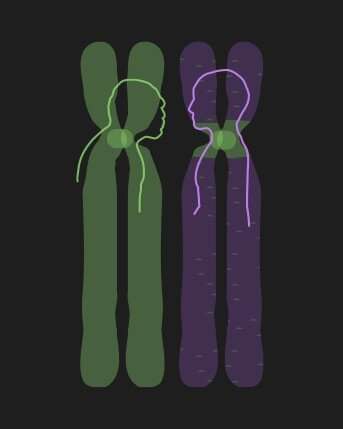Dark centers of chromosomes reveal ancient DNA

Geneticists exploring the dark heart of the human genome have discovered big chunks of Neanderthal and other ancient DNA. The results open new ways to study both how chromosomes behave during cell division and how they have changed during human evolution.
Centromeres sit in the middle of chromosomes, the pinched-in "waist" in the image of a chromosome from a biology textbook. The centromere anchors the fibers that pull chromosomes apart when cells divide, which means they are really important for understanding what happens when cell division goes wrong, leading to cancer or genetic defects.
But the DNA of centromeres contains lots of repeating sequences, and scientists have been unable to properly map this region.
"It's the heart of darkness of the genome, we warn students not to go there," said Charles Langley, professor of evolution and ecology at UC Davis. Langley is senior author on a paper describing the work published June 18 in the journal eLife.
Langley and colleagues Sasha Langley and Gary Karpen at the Lawrence Berkeley Laboratory and Karen Miga at UC Santa Cruz reasoned that there could be haplotypes—groups of genes that are inherited together in human evolution—that stretch over vast portions of our genomes, and even across the centromere.
That's because the centromere does not participate in the "crossover" process that occurs when cells divide to form sperm or eggs. During crossover, paired chromosomes line up next to each other and their limbs cross, sometimes cutting and splicing DNA between them so that genes can be shuffled. But crossovers drop to zero near centromeres. Without that shuffling in every generation, centromeres might preserve very ancient stretches of DNA intact.
The researchers looked for inherited single nucleotide polymorphisms—inherited changes in a single letter of DNA—that would allow them to map haplotypes in the centromere.
They first showed that they could identify centromeric haplotypes, or "cenhaps," in Drosophila fruit flies.
That finding has two implications, Langley said. Firstly, if researchers can distinguish chromosomes from each other by their centromeres, they can start to carry out functional tests to see if these differences have an impact on which piece of DNA is inherited. For example, during egg formation, four chromatids are formed from two chromosomes, but only one makes it into the egg. So scientists want to know: Are certain centromere haplotypes transmitted more often? And are some haplotypes more likely to be involved in errors?
Secondly, researchers can use centromeres to look at ancestry and evolutionary descent.
Turning to human DNA, the researchers looked at centromere sequences from the 1000 Genomes Project, a public catalog of human variation. They discovered haplotypes spanning the centromeres in all the human chromosomes.
Haplotypes from half a million years ago
In the X chromosome in these genome sequences, they found several major centromeric haplotypes representing lineages stretching back a half a million years. In the genome as a whole, most of the diversity is seen among African genomes consistent with the more recent spread of humans out of the African continent. One of the oldest centromere haplotype lineages was not carried by those early emigrants.
In chromosome 11, they found highly diverged haplotypes of Neanderthal DNA in non-African genomes. These haplotypes diverged between 700,000 to a million years ago, around the time the ancestors of Neanderthals split from other human ancestors. The centromere of chromosome 12 also contains an even more ancient, archaic haplotype that appears to be derived from an unknown relative.
This Neanderthal DNA on chromosome 11 could be influencing differences in our sense of smell to this day. The cells that respond to taste and smell carry odorant receptors triggered by specific chemical signatures. Humans have about 400 different genes for odorant receptors. Thirty-four of these genes reside within the chromosome 11 centromere haplotype. The Neanderthal centromeric haplotypes and a second ancient haplotype account for about half of the variation in these odorant receptor proteins.
It's known from work by others that genetic variation in odorant receptors can influence sense of taste and smell, but the functional effects of the variation found in this study are yet to be discovered and their impact on taste and smell analyzed.
More information: eLife, DOI: 10.7554/eLife.42989
Journal information: eLife
Provided by UC Davis





















